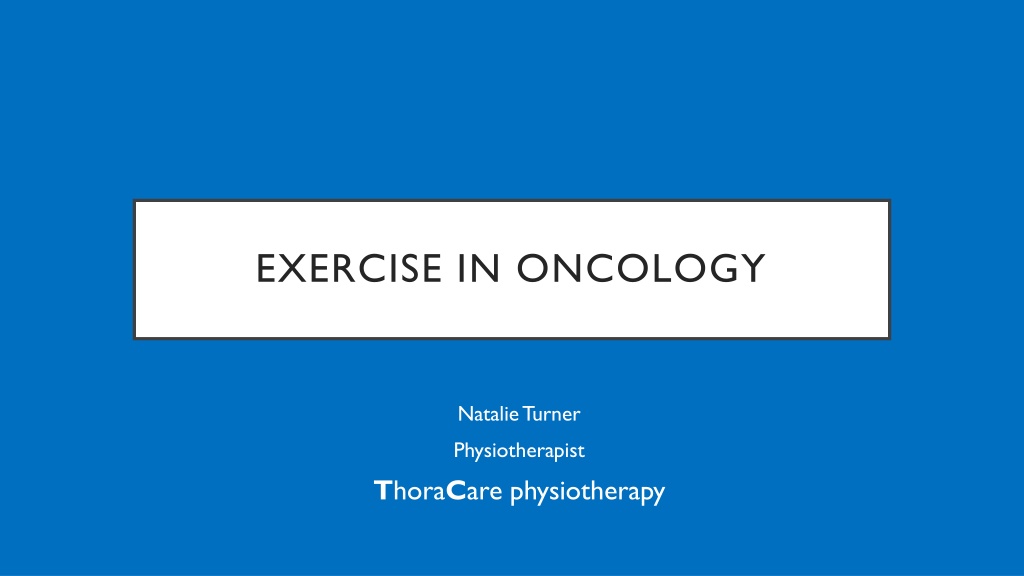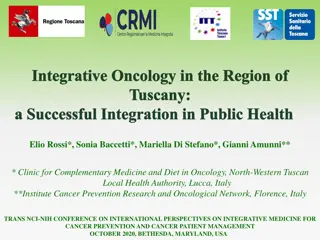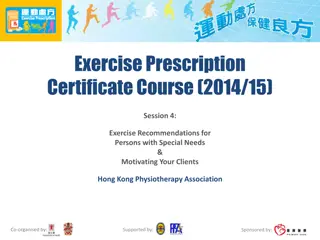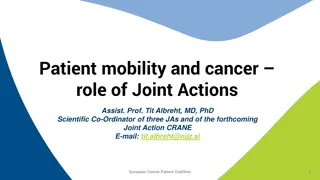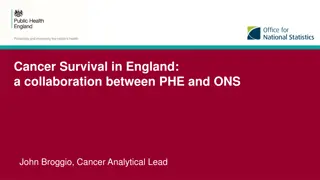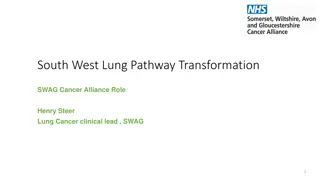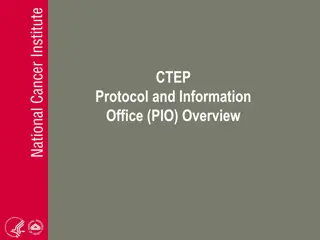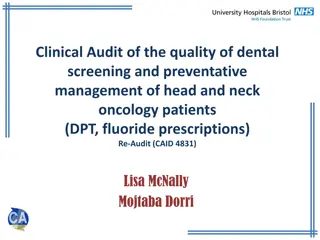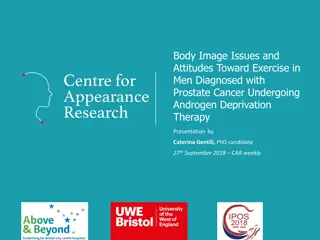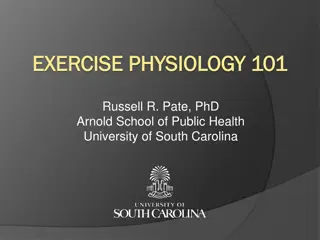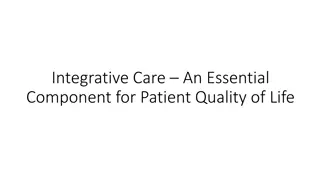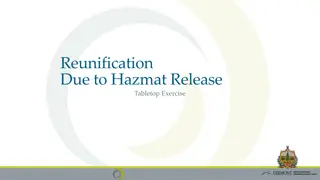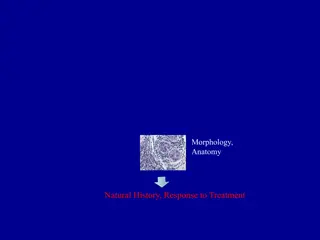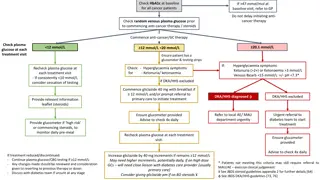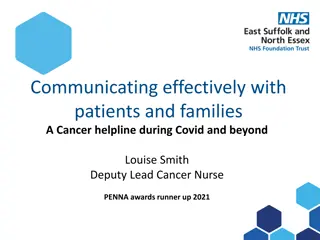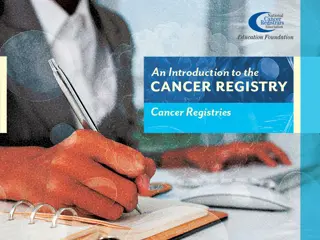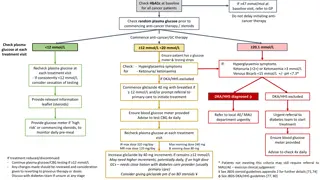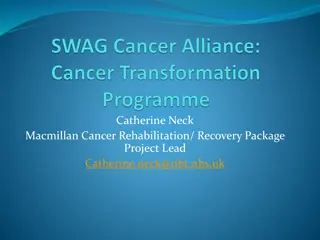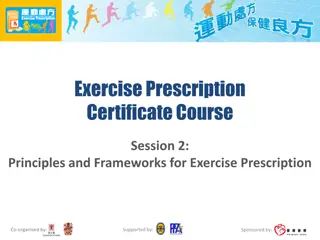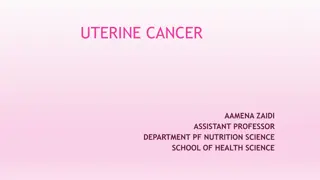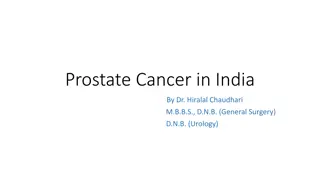Exercise in Oncology: Benefits and Importance for Cancer Patients
Exercise has significant benefits for cancer patients, improving quality of life, managing fatigue, reducing functional decline, anxiety, and depression. Despite the evidence, only a small percentage of individuals with cancer exercise enough during treatment. The prehabilitation model emphasizes the importance of introducing exercise early in the cancer care plan, showing positive outcomes in recovery and tolerance. Integrating exercise as medicine in oncology can lead to better treatment success and overall patient outcomes.
Download Presentation

Please find below an Image/Link to download the presentation.
The content on the website is provided AS IS for your information and personal use only. It may not be sold, licensed, or shared on other websites without obtaining consent from the author. Download presentation by click this link. If you encounter any issues during the download, it is possible that the publisher has removed the file from their server.
E N D
Presentation Transcript
EXERCISE IN ONCOLOGY Natalie Turner Physiotherapist ThoraCare physiotherapy
If we could turn the benefits of exercise into a pill it would be demanded by patients, prescribed by every cancer specialist and subsidised by the government -Prue Cormie ThoraCare physiotherapy
OVERVIEW Exercise Why exercise? Exercise is medicine The evidence When to start exercise in the cancer journey Percieved barriers and precautions Exercise prescription Implications for practice ThoraCare physiotherapy
CANCER- BURDEN OF DISEASE Australia s largest cause of disease burden currently Cancer diagnosis made every 4 minutes! Highest rates of breast, colorectal, prostate and melanoma 3 in every 10 deaths Improved treatment strategies = increased survival (approximately 340,000 survivors in Australia) (AIHW, 2017; Cormie et al., 2017) ThoraCare physiotherapy
EXERCISE Physical Activity: Any bodily movement produced by the contraction of skeletal muscle that results in a substantal increase in caloric requirements over resting energy expenditure. Exercise: Physical activity consisting of planned, structured ad repetitive body movements for the purpose of improving and/or maintainin health and physical fitness. Only 1 in 10 individuals with cancer exercise sufficiently during their cancer treatment! ThoraCare physiotherapy (Cormie et al., 2018; Lakoski et al., 2012)
WHY EXERCISE? There is significant evidence around exercise and its effects on: Improving quality of life Managing cancer related fatigue Reducing functional decline Reducing anxiety and depression Reducing risk of comorbid conditions HOWEVER Emerging evidence suggests that exercise can improve treatment success and overall patient outcomes. (Heywood et al., 2018) ThoraCare physiotherapy
Published in the Medical Journal of Australia ThoraCare physiotherapy
WHEN TO START EXERCISE? The prehabilitation model of care: A proactive approach to introducing exercise and rehabilitation into the cancer care plan from the point of diagnosis has shown positive outcomes Important findings regarding improved recovery and tolerance to treatment with early initiation (Stout et al., 2017) ThoraCare physiotherapy
BEFORE AND DURING TREATMENT Patients have > 30% reduction in physical activity during hospitalisation Cancer survivors have significantly lower fitness post treatment E.g. In breast cancer a 50 year old survivor has the cardiorespiratory fitness of someone who is 70 years old and sedentary (Stout et al., 2017) ThoraCare physiotherapy
EXERCISE IS MEDICINE IN ONCOLOGY Exercise can: Reduce side effects of medical treatment Reduce the risk of dying from cancer Reduce the recurrence rate Possible mechanisms: Improved physical fitness leads to improved tolerance of, or ability to receive radiotherapy or chemotherapy Fewer complications from surgical treatment Biological mechanisms (positive changes to immune or endocrine systems from exercise) (Cormie et al., 2017; Stout et al., 2017) ThoraCare physiotherapy
Increased levels of exercise following a cancer diagnosis were associated with: 28% 44% lower risk of cancer-specific mortality 21% 35% lower risk of cancer recurrence 25% 48% decreased risk of all-cause mortality ThoraCare physiotherapy
Key message- Overall improvements in tolerance to cancer treatment and functional outcomes occur when exercise is initiated before or during cancer treatment ThoraCare physiotherapy
BREAKING DOWN BARRIERS Exercise is safe and feasible Before, during and after treatment Does not interfere with treatment completion rate or clinical response to treatment Appropriate in advanced cancer Exercise is first line treatment for cancer related fatigue (CRF) There is significant evidence supporting exercise use in CRF It is the MOST effective method for managing CRF Exercise is MORE effective than pharmacutical or psychological method (Heywood et al, 2018 Mustian et al, 2016; Dennett et al, 2016) ThoraCare physiotherapy
EXERCISE PRESCRIPTION Exercise should be individually prescribed and tailored by an accredited physiotherapist or exercise physiologist with experience working in the field of cancer care. (Dennett et al., 2016) ThoraCare physiotherapy
EXERCISE PRESCRIPTION Clincal Oncology Society of Australia Exercise Guidelines: At least 150 minutes of moderate intensity aerobic exercise weekly (such as walking, jogging, cycling, swimming) Two to three resistance exercise session each week involving moderate to vigorous intensity exercises targeting the major muscle groups (such as weight lifting) Consideration of environment in relation to immunosupression Specific goal setting Supervised (Cormie et al., 2018; Turner et al, 2018) ThoraCare physiotherapy
CANCER SPECIFIC PRECAUTIONS Precaution Action Blood count (e.g.reduced haemoglobin, anaemia) Reduced platelets Avoid activites that require significant oxygen transportation Avoid activities that reduce risk of bleeding (e.g weights, contact sport) Avoid activities with significant load or impact, or unstable/high level balance exercises Mild intensity exercise Bony metastases Severe cachexia (loss of >35% pre-morbid weight) Extreme fatigue, nausea, dysponea Exercise to tolerance, monitor. Further investigation may be warranted Avoid activities that increase risk of infection Reduced white cell count/ Immunosuppression (Peter MaCallum Cancer Centre, 2016) ThoraCare physiotherapy
IMPLICATIONS FOR PRACTICE Exercise should be seen as part of standard care for those living with cancer Exercise should be promoted by all members of the multidisciplinary team Education to patients is crucial Commencing exercise early appears to be key There are many referral options.. Cancer Council is a great resource for finding appropriate programs across WA ThoraCare physiotherapy
Australian Institute of Health and Welfare. (2017). Cancer in Australia 2017. Cancer series 101. Cat no CAN. 100, Canberra: AIHW. Cormie, P., Atkinson, M., Bucci, L., Cust, A., Eakin, E., Hayes, S., ... & Adams, D. (2018). Clinical Oncology Society of Australia position statement on exercise in cancer care. Medical Journal of Australia, 209(4), 184-187. Cormie, P., Zopf, E. M., Zhang, X., & Schmitz, K. H. (2017). The impact of exercise on cancer mortality, recurrence, and treatment-related adverse effects. Epidemiologic reviews, 39(1), 71-92. Dennett, A. M., Peiris, C. L., Shields, N., Prendergast, L. A., & Taylor, N. F. (2016). Moderate-intensity exercise reduces fatigue and improves mobility in cancer survivors: a systematic review and meta- regression. Journal of physiotherapy, 62(2), 68-82. Heywood, R., McCarthy, A. L., & Skinner, T. L. (2018). Efficacy of exercise interventions in patients with advanced cancer: A systematic review. Archives of physical medicine and rehabilitation, 99(12), 2595- 2620. Lakoski, S. G., Eves, N. D., Douglas, P. S., & Jones, L. W. (2012). Exercise rehabilitation in patients with cancer. Nature reviews Clinical oncology, 9(5), 288. Mustian, K. M., Cole, C. L., Lin, P. J., Asare, M., Fung, C., Janelsins, M. C., ... & Magnuson, A. (2016, November). Exercise recommendations for the management of symptoms clusters resulting from cancer and cancer treatments. In Seminars in oncology nursing (Vol. 32, No. 4, pp. 383-393). WB Saunders. Peter MacCallum Cancer Centre Physiotherapy Department (2017). Introduction to Oncology for Physiotherapists and Exercise Professionals. Turner, R. R., Steed, L., Quirk, H., Greasley, R. U., Saxton, J. M., Taylor, S. J., ... & Bourke, L. (2018). Interventions for promoting habitual exercise in people living with and beyond cancer. Cochrane Database of Systematic Reviews, (9). ThoraCare physiotherapy
